Analyzing the Impact of US-China Trade War on Australian Economy
VerifiedAdded on 2022/11/13
|28
|7456
|470
Report
AI Summary
This economics report analyzes the impact of the US-China trade war on the Australian economy. It begins with an overview of the trade war's origins, including Trump's justifications for tariffs and China's responses, such as retaliatory tariffs, currency manipulation, and reduced investment. The report explores the concept of free trade, comparative advantage, and the role of global value chains, highlighting the negative effects of protectionism. The report also examines the specific measures taken by both countries, including the imposition of tariffs on various goods. The report then delves into how the trade war affects the Australian economy. The report concludes by discussing the current state of the trade war, including the ongoing negotiations and the potential for further escalation, and provides references for further study. The report emphasizes the economic consequences of trade restrictions and their impact on global markets and trade imbalances.
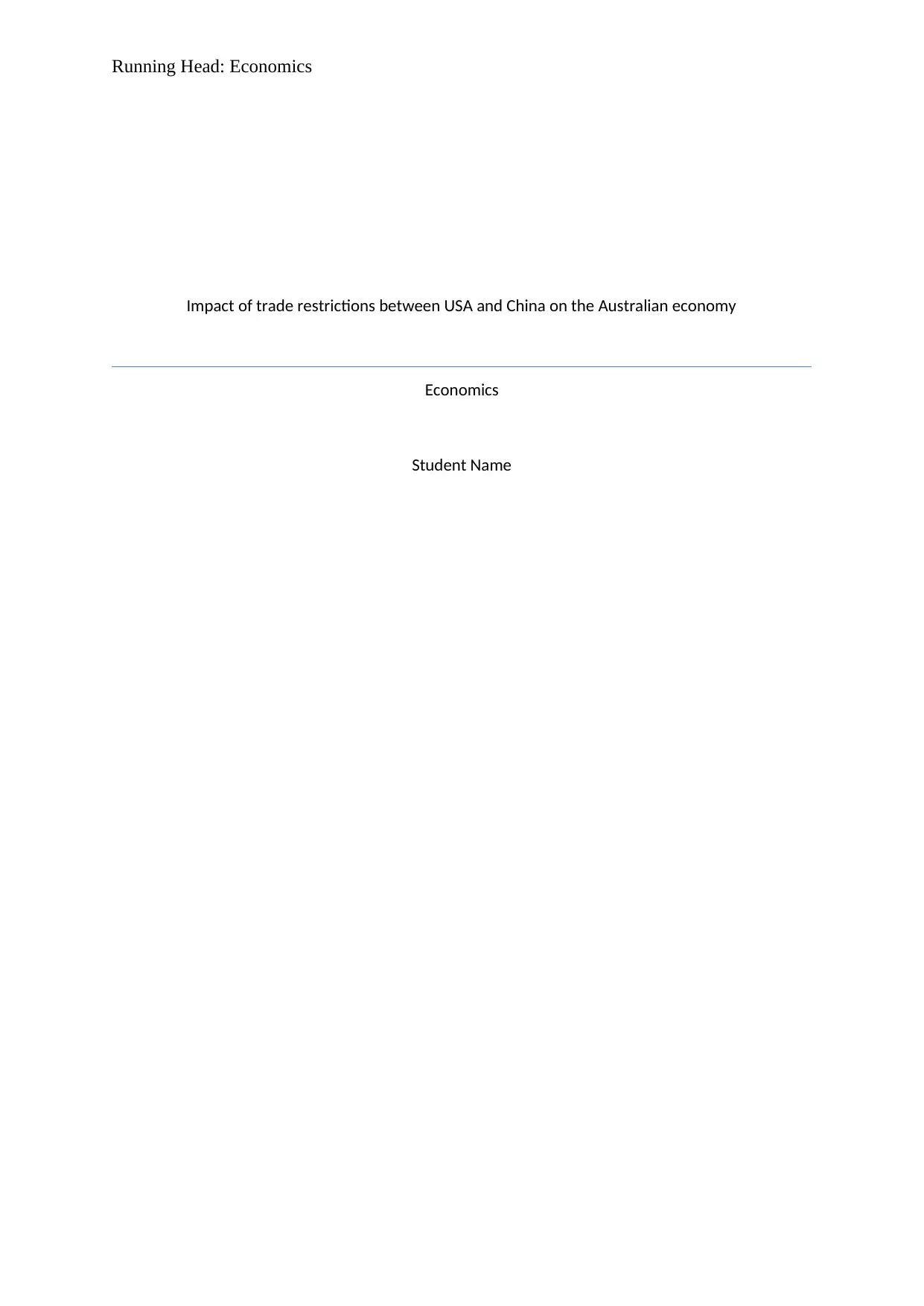
Running Head: Economics
Impact of trade restrictions between USA and China on the Australian economy
Economics
Student Name
Impact of trade restrictions between USA and China on the Australian economy
Economics
Student Name
Paraphrase This Document
Need a fresh take? Get an instant paraphrase of this document with our AI Paraphraser
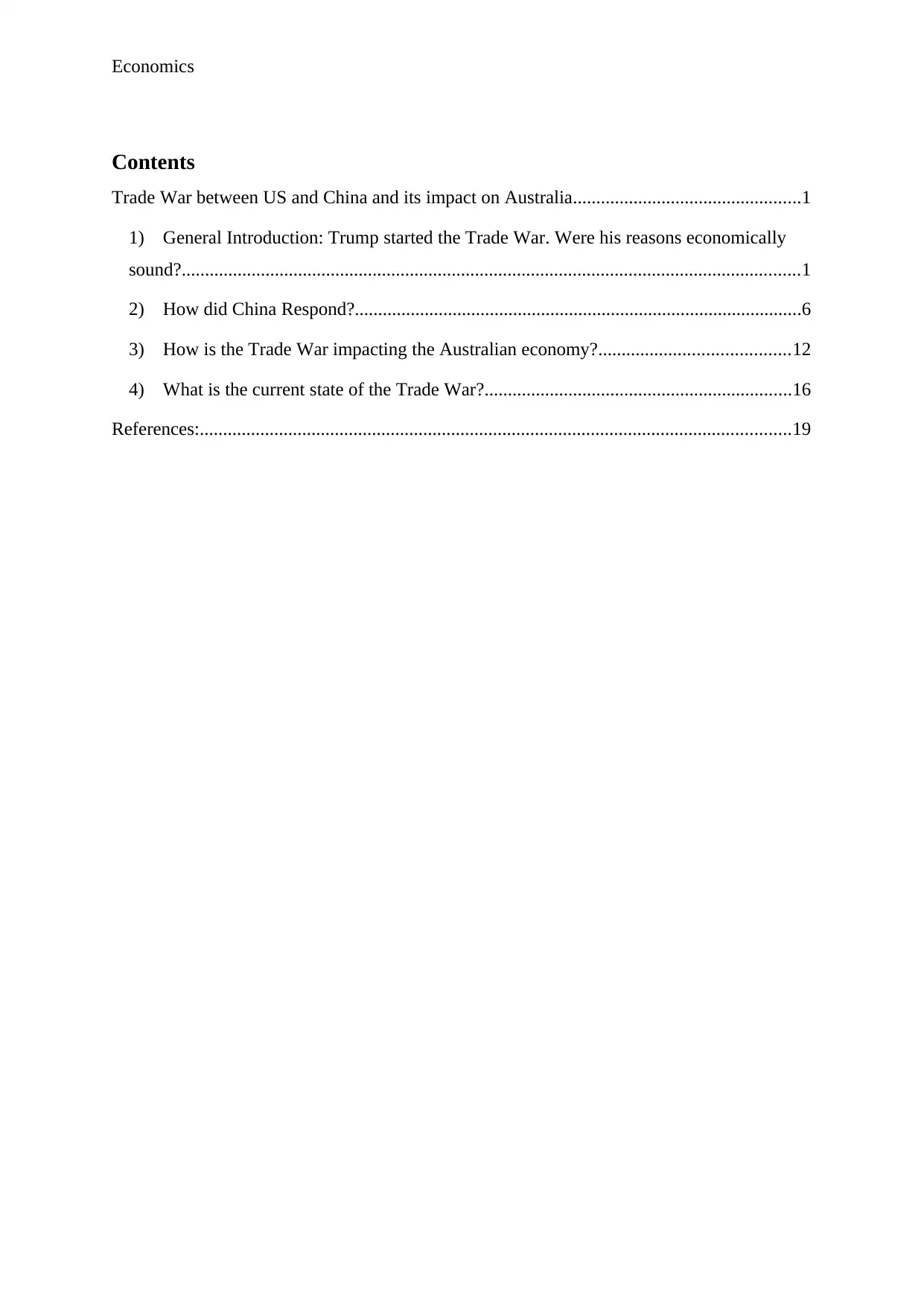
Economics
Contents
Trade War between US and China and its impact on Australia.................................................1
1) General Introduction: Trump started the Trade War. Were his reasons economically
sound?.....................................................................................................................................1
2) How did China Respond?................................................................................................6
3) How is the Trade War impacting the Australian economy?.........................................12
4) What is the current state of the Trade War?..................................................................16
References:...............................................................................................................................19
Contents
Trade War between US and China and its impact on Australia.................................................1
1) General Introduction: Trump started the Trade War. Were his reasons economically
sound?.....................................................................................................................................1
2) How did China Respond?................................................................................................6
3) How is the Trade War impacting the Australian economy?.........................................12
4) What is the current state of the Trade War?..................................................................16
References:...............................................................................................................................19
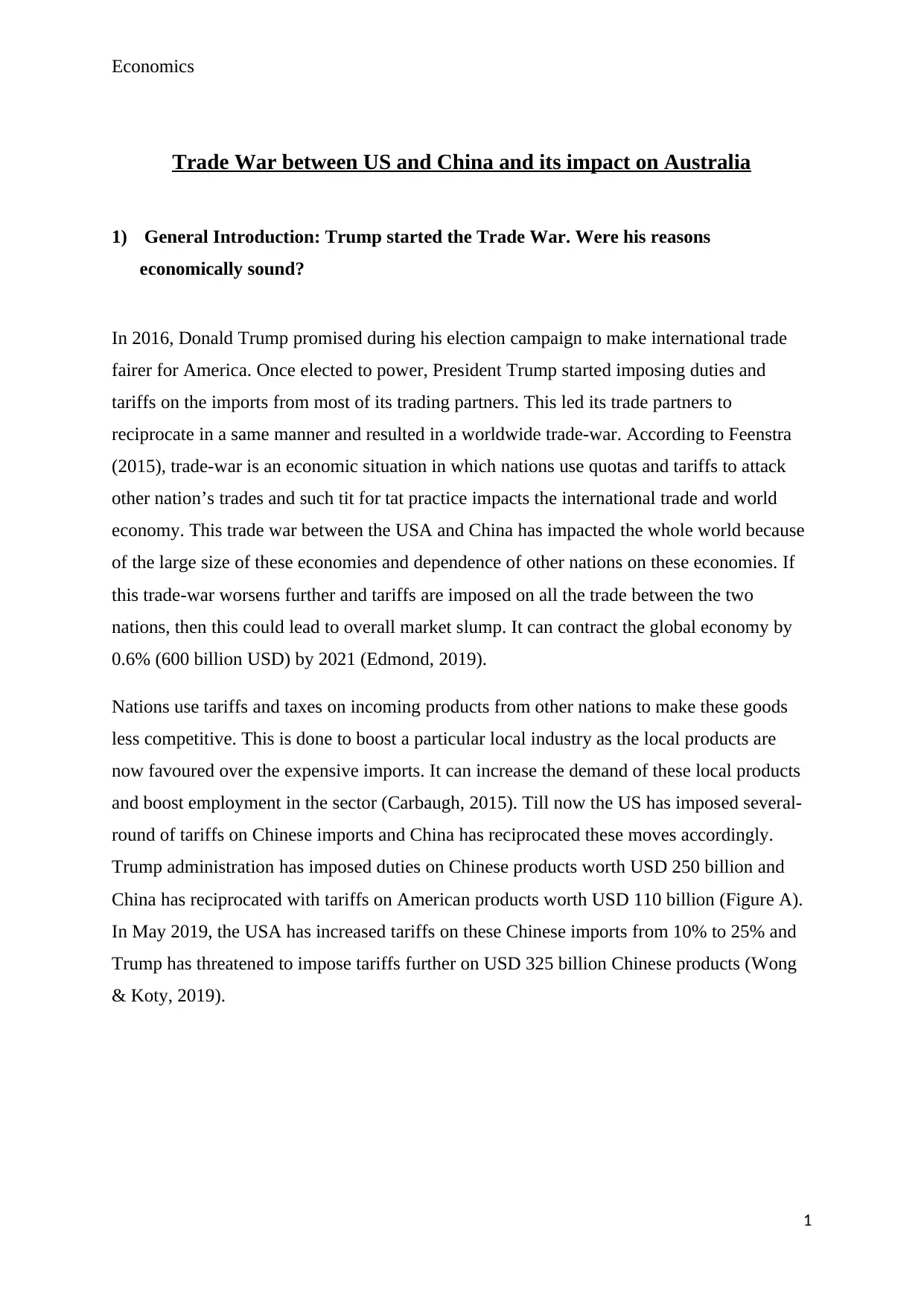
Economics
Trade War between US and China and its impact on Australia
1) General Introduction: Trump started the Trade War. Were his reasons
economically sound?
In 2016, Donald Trump promised during his election campaign to make international trade
fairer for America. Once elected to power, President Trump started imposing duties and
tariffs on the imports from most of its trading partners. This led its trade partners to
reciprocate in a same manner and resulted in a worldwide trade-war. According to Feenstra
(2015), trade-war is an economic situation in which nations use quotas and tariffs to attack
other nation’s trades and such tit for tat practice impacts the international trade and world
economy. This trade war between the USA and China has impacted the whole world because
of the large size of these economies and dependence of other nations on these economies. If
this trade-war worsens further and tariffs are imposed on all the trade between the two
nations, then this could lead to overall market slump. It can contract the global economy by
0.6% (600 billion USD) by 2021 (Edmond, 2019).
Nations use tariffs and taxes on incoming products from other nations to make these goods
less competitive. This is done to boost a particular local industry as the local products are
now favoured over the expensive imports. It can increase the demand of these local products
and boost employment in the sector (Carbaugh, 2015). Till now the US has imposed several-
round of tariffs on Chinese imports and China has reciprocated these moves accordingly.
Trump administration has imposed duties on Chinese products worth USD 250 billion and
China has reciprocated with tariffs on American products worth USD 110 billion (Figure A).
In May 2019, the USA has increased tariffs on these Chinese imports from 10% to 25% and
Trump has threatened to impose tariffs further on USD 325 billion Chinese products (Wong
& Koty, 2019).
1
Trade War between US and China and its impact on Australia
1) General Introduction: Trump started the Trade War. Were his reasons
economically sound?
In 2016, Donald Trump promised during his election campaign to make international trade
fairer for America. Once elected to power, President Trump started imposing duties and
tariffs on the imports from most of its trading partners. This led its trade partners to
reciprocate in a same manner and resulted in a worldwide trade-war. According to Feenstra
(2015), trade-war is an economic situation in which nations use quotas and tariffs to attack
other nation’s trades and such tit for tat practice impacts the international trade and world
economy. This trade war between the USA and China has impacted the whole world because
of the large size of these economies and dependence of other nations on these economies. If
this trade-war worsens further and tariffs are imposed on all the trade between the two
nations, then this could lead to overall market slump. It can contract the global economy by
0.6% (600 billion USD) by 2021 (Edmond, 2019).
Nations use tariffs and taxes on incoming products from other nations to make these goods
less competitive. This is done to boost a particular local industry as the local products are
now favoured over the expensive imports. It can increase the demand of these local products
and boost employment in the sector (Carbaugh, 2015). Till now the US has imposed several-
round of tariffs on Chinese imports and China has reciprocated these moves accordingly.
Trump administration has imposed duties on Chinese products worth USD 250 billion and
China has reciprocated with tariffs on American products worth USD 110 billion (Figure A).
In May 2019, the USA has increased tariffs on these Chinese imports from 10% to 25% and
Trump has threatened to impose tariffs further on USD 325 billion Chinese products (Wong
& Koty, 2019).
1
⊘ This is a preview!⊘
Do you want full access?
Subscribe today to unlock all pages.

Trusted by 1+ million students worldwide
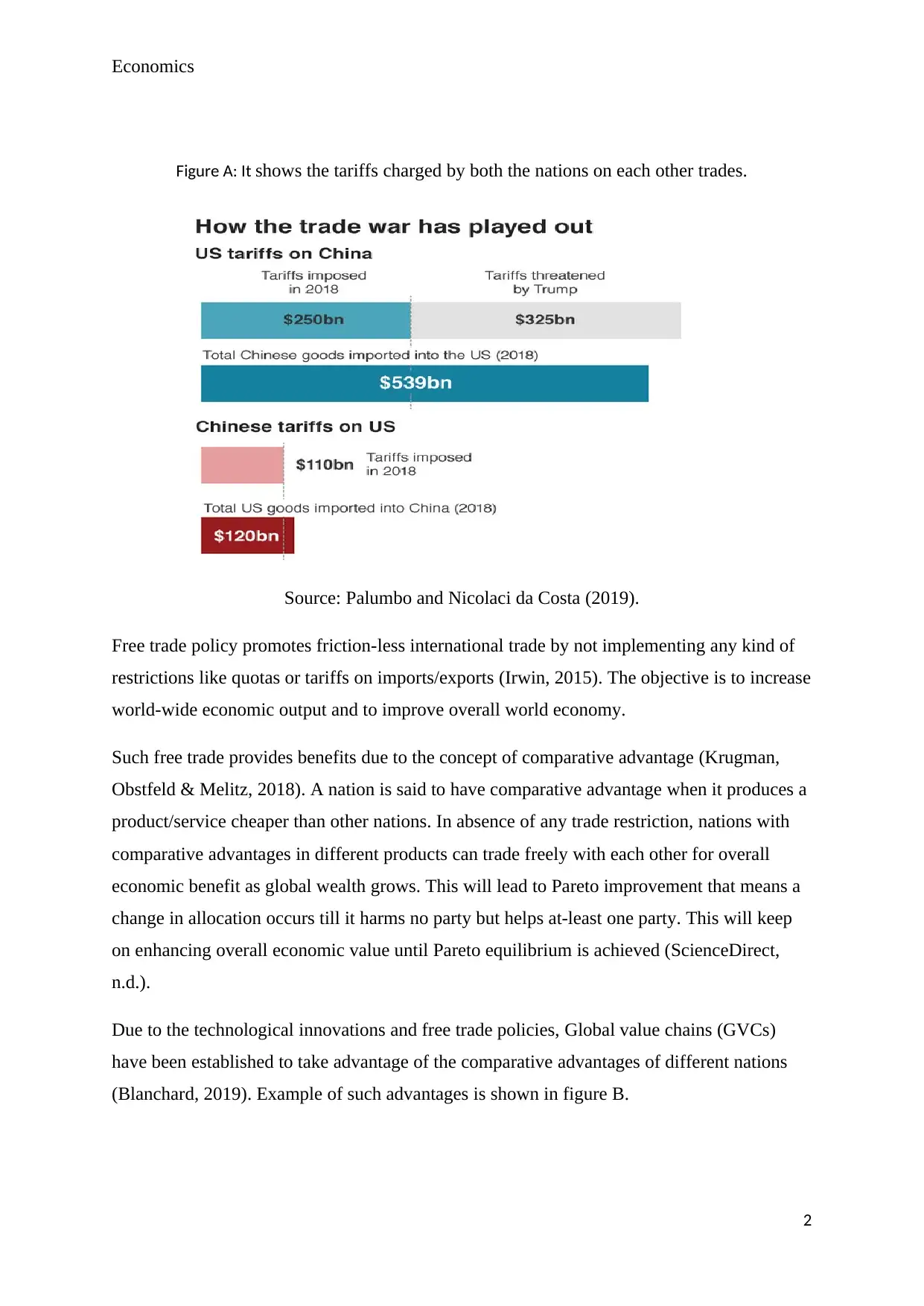
Economics
Figure A: It shows the tariffs charged by both the nations on each other trades.
Source: Palumbo and Nicolaci da Costa (2019).
Free trade policy promotes friction-less international trade by not implementing any kind of
restrictions like quotas or tariffs on imports/exports (Irwin, 2015). The objective is to increase
world-wide economic output and to improve overall world economy.
Such free trade provides benefits due to the concept of comparative advantage (Krugman,
Obstfeld & Melitz, 2018). A nation is said to have comparative advantage when it produces a
product/service cheaper than other nations. In absence of any trade restriction, nations with
comparative advantages in different products can trade freely with each other for overall
economic benefit as global wealth grows. This will lead to Pareto improvement that means a
change in allocation occurs till it harms no party but helps at-least one party. This will keep
on enhancing overall economic value until Pareto equilibrium is achieved (ScienceDirect,
n.d.).
Due to the technological innovations and free trade policies, Global value chains (GVCs)
have been established to take advantage of the comparative advantages of different nations
(Blanchard, 2019). Example of such advantages is shown in figure B.
2
Figure A: It shows the tariffs charged by both the nations on each other trades.
Source: Palumbo and Nicolaci da Costa (2019).
Free trade policy promotes friction-less international trade by not implementing any kind of
restrictions like quotas or tariffs on imports/exports (Irwin, 2015). The objective is to increase
world-wide economic output and to improve overall world economy.
Such free trade provides benefits due to the concept of comparative advantage (Krugman,
Obstfeld & Melitz, 2018). A nation is said to have comparative advantage when it produces a
product/service cheaper than other nations. In absence of any trade restriction, nations with
comparative advantages in different products can trade freely with each other for overall
economic benefit as global wealth grows. This will lead to Pareto improvement that means a
change in allocation occurs till it harms no party but helps at-least one party. This will keep
on enhancing overall economic value until Pareto equilibrium is achieved (ScienceDirect,
n.d.).
Due to the technological innovations and free trade policies, Global value chains (GVCs)
have been established to take advantage of the comparative advantages of different nations
(Blanchard, 2019). Example of such advantages is shown in figure B.
2
Paraphrase This Document
Need a fresh take? Get an instant paraphrase of this document with our AI Paraphraser
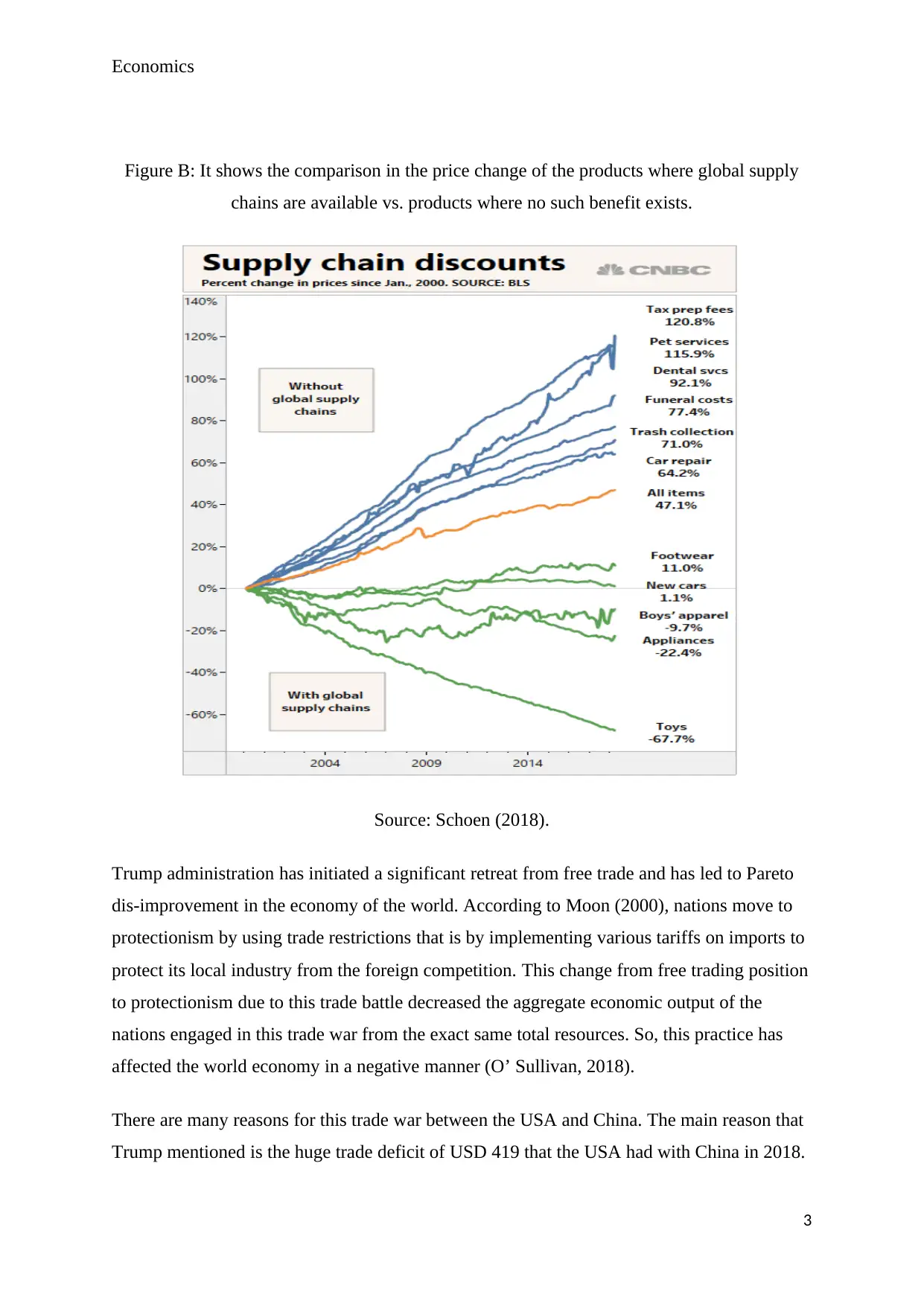
Economics
Figure B: It shows the comparison in the price change of the products where global supply
chains are available vs. products where no such benefit exists.
Source: Schoen (2018).
Trump administration has initiated a significant retreat from free trade and has led to Pareto
dis-improvement in the economy of the world. According to Moon (2000), nations move to
protectionism by using trade restrictions that is by implementing various tariffs on imports to
protect its local industry from the foreign competition. This change from free trading position
to protectionism due to this trade battle decreased the aggregate economic output of the
nations engaged in this trade war from the exact same total resources. So, this practice has
affected the world economy in a negative manner (O’ Sullivan, 2018).
There are many reasons for this trade war between the USA and China. The main reason that
Trump mentioned is the huge trade deficit of USD 419 that the USA had with China in 2018.
3
Figure B: It shows the comparison in the price change of the products where global supply
chains are available vs. products where no such benefit exists.
Source: Schoen (2018).
Trump administration has initiated a significant retreat from free trade and has led to Pareto
dis-improvement in the economy of the world. According to Moon (2000), nations move to
protectionism by using trade restrictions that is by implementing various tariffs on imports to
protect its local industry from the foreign competition. This change from free trading position
to protectionism due to this trade battle decreased the aggregate economic output of the
nations engaged in this trade war from the exact same total resources. So, this practice has
affected the world economy in a negative manner (O’ Sullivan, 2018).
There are many reasons for this trade war between the USA and China. The main reason that
Trump mentioned is the huge trade deficit of USD 419 that the USA had with China in 2018.
3
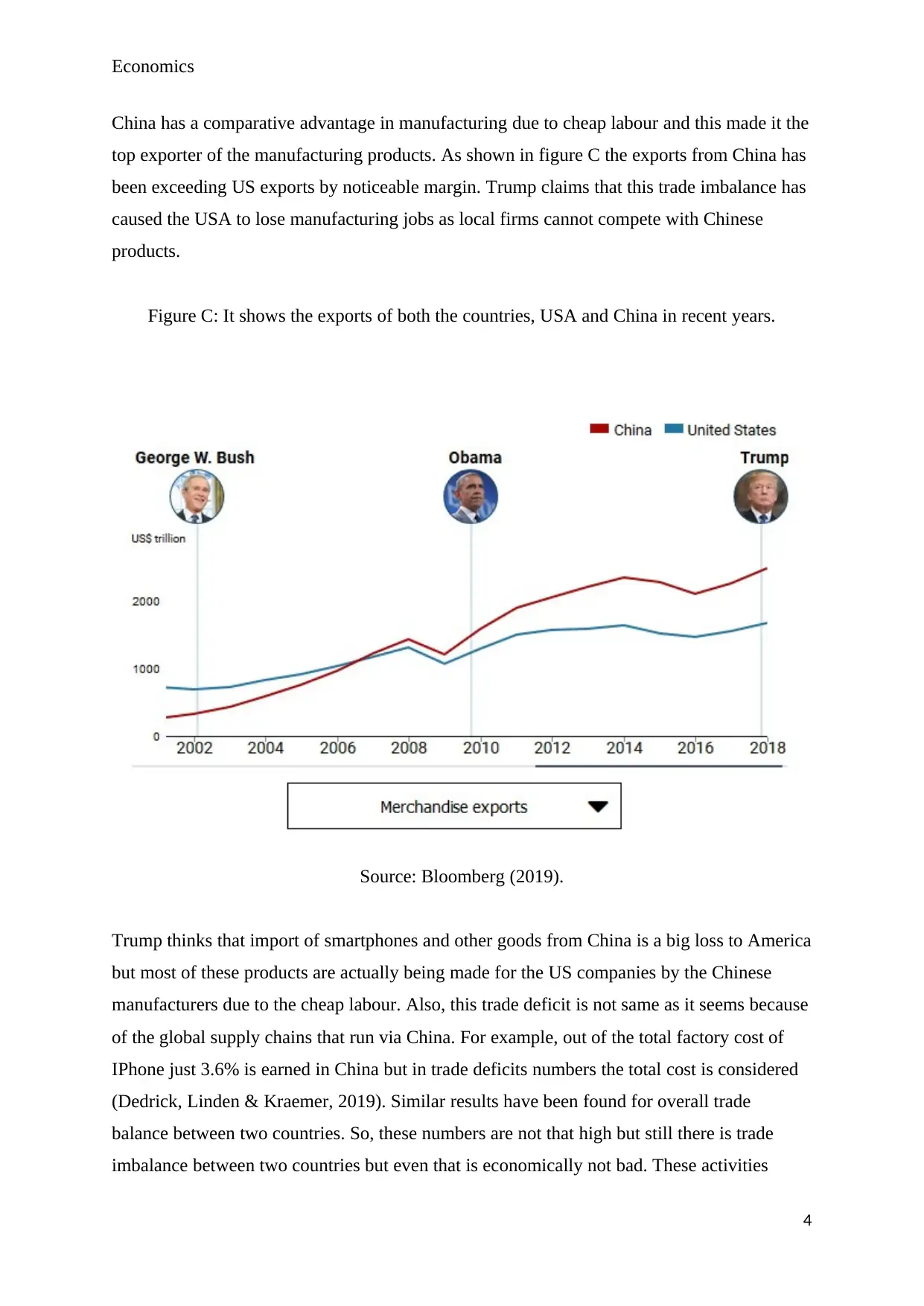
Economics
China has a comparative advantage in manufacturing due to cheap labour and this made it the
top exporter of the manufacturing products. As shown in figure C the exports from China has
been exceeding US exports by noticeable margin. Trump claims that this trade imbalance has
caused the USA to lose manufacturing jobs as local firms cannot compete with Chinese
products.
Figure C: It shows the exports of both the countries, USA and China in recent years.
Source: Bloomberg (2019).
Trump thinks that import of smartphones and other goods from China is a big loss to America
but most of these products are actually being made for the US companies by the Chinese
manufacturers due to the cheap labour. Also, this trade deficit is not same as it seems because
of the global supply chains that run via China. For example, out of the total factory cost of
IPhone just 3.6% is earned in China but in trade deficits numbers the total cost is considered
(Dedrick, Linden & Kraemer, 2019). Similar results have been found for overall trade
balance between two countries. So, these numbers are not that high but still there is trade
imbalance between two countries but even that is economically not bad. These activities
4
China has a comparative advantage in manufacturing due to cheap labour and this made it the
top exporter of the manufacturing products. As shown in figure C the exports from China has
been exceeding US exports by noticeable margin. Trump claims that this trade imbalance has
caused the USA to lose manufacturing jobs as local firms cannot compete with Chinese
products.
Figure C: It shows the exports of both the countries, USA and China in recent years.
Source: Bloomberg (2019).
Trump thinks that import of smartphones and other goods from China is a big loss to America
but most of these products are actually being made for the US companies by the Chinese
manufacturers due to the cheap labour. Also, this trade deficit is not same as it seems because
of the global supply chains that run via China. For example, out of the total factory cost of
IPhone just 3.6% is earned in China but in trade deficits numbers the total cost is considered
(Dedrick, Linden & Kraemer, 2019). Similar results have been found for overall trade
balance between two countries. So, these numbers are not that high but still there is trade
imbalance between two countries but even that is economically not bad. These activities
4
⊘ This is a preview!⊘
Do you want full access?
Subscribe today to unlock all pages.

Trusted by 1+ million students worldwide
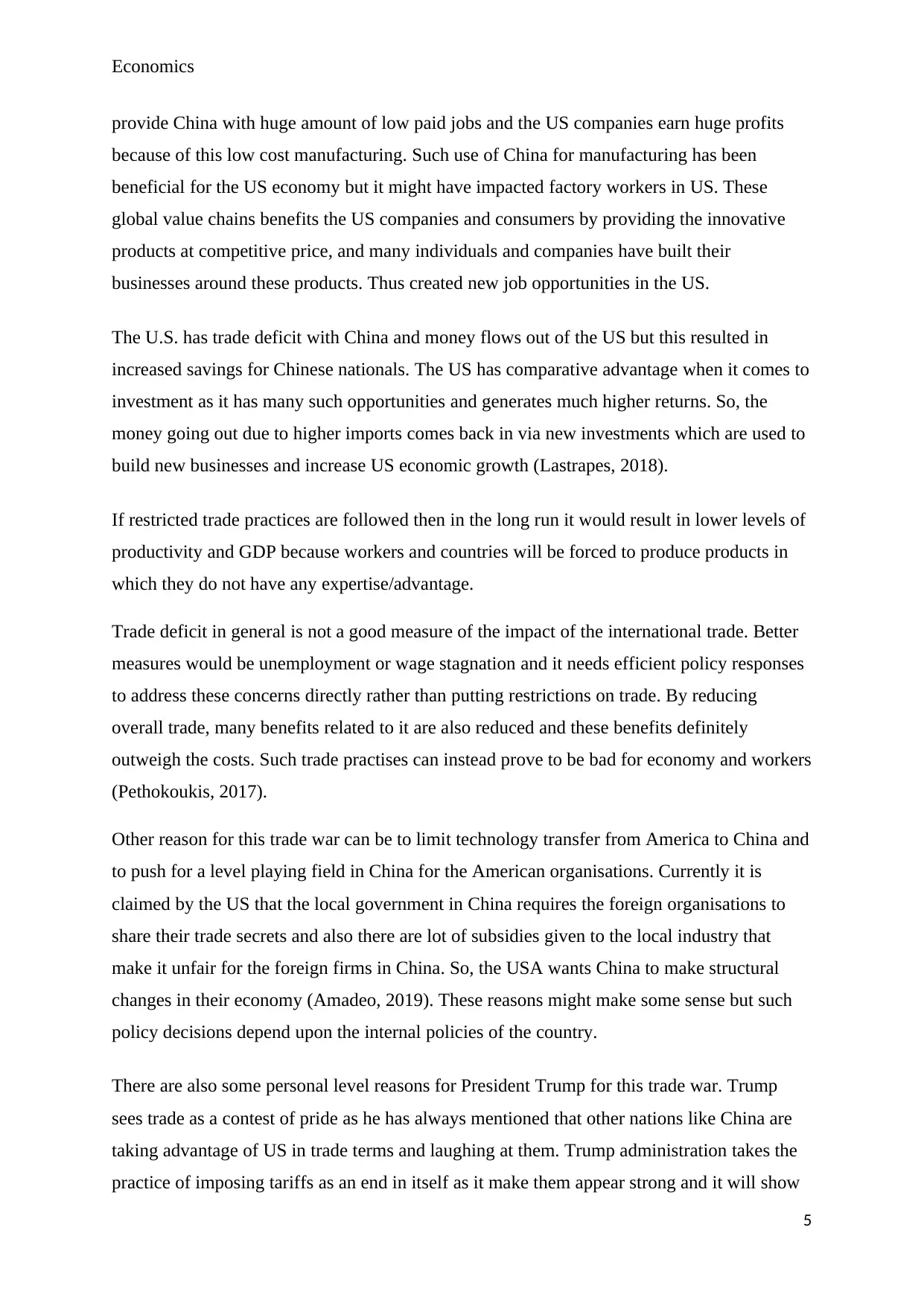
Economics
provide China with huge amount of low paid jobs and the US companies earn huge profits
because of this low cost manufacturing. Such use of China for manufacturing has been
beneficial for the US economy but it might have impacted factory workers in US. These
global value chains benefits the US companies and consumers by providing the innovative
products at competitive price, and many individuals and companies have built their
businesses around these products. Thus created new job opportunities in the US.
The U.S. has trade deficit with China and money flows out of the US but this resulted in
increased savings for Chinese nationals. The US has comparative advantage when it comes to
investment as it has many such opportunities and generates much higher returns. So, the
money going out due to higher imports comes back in via new investments which are used to
build new businesses and increase US economic growth (Lastrapes, 2018).
If restricted trade practices are followed then in the long run it would result in lower levels of
productivity and GDP because workers and countries will be forced to produce products in
which they do not have any expertise/advantage.
Trade deficit in general is not a good measure of the impact of the international trade. Better
measures would be unemployment or wage stagnation and it needs efficient policy responses
to address these concerns directly rather than putting restrictions on trade. By reducing
overall trade, many benefits related to it are also reduced and these benefits definitely
outweigh the costs. Such trade practises can instead prove to be bad for economy and workers
(Pethokoukis, 2017).
Other reason for this trade war can be to limit technology transfer from America to China and
to push for a level playing field in China for the American organisations. Currently it is
claimed by the US that the local government in China requires the foreign organisations to
share their trade secrets and also there are lot of subsidies given to the local industry that
make it unfair for the foreign firms in China. So, the USA wants China to make structural
changes in their economy (Amadeo, 2019). These reasons might make some sense but such
policy decisions depend upon the internal policies of the country.
There are also some personal level reasons for President Trump for this trade war. Trump
sees trade as a contest of pride as he has always mentioned that other nations like China are
taking advantage of US in trade terms and laughing at them. Trump administration takes the
practice of imposing tariffs as an end in itself as it make them appear strong and it will show
5
provide China with huge amount of low paid jobs and the US companies earn huge profits
because of this low cost manufacturing. Such use of China for manufacturing has been
beneficial for the US economy but it might have impacted factory workers in US. These
global value chains benefits the US companies and consumers by providing the innovative
products at competitive price, and many individuals and companies have built their
businesses around these products. Thus created new job opportunities in the US.
The U.S. has trade deficit with China and money flows out of the US but this resulted in
increased savings for Chinese nationals. The US has comparative advantage when it comes to
investment as it has many such opportunities and generates much higher returns. So, the
money going out due to higher imports comes back in via new investments which are used to
build new businesses and increase US economic growth (Lastrapes, 2018).
If restricted trade practices are followed then in the long run it would result in lower levels of
productivity and GDP because workers and countries will be forced to produce products in
which they do not have any expertise/advantage.
Trade deficit in general is not a good measure of the impact of the international trade. Better
measures would be unemployment or wage stagnation and it needs efficient policy responses
to address these concerns directly rather than putting restrictions on trade. By reducing
overall trade, many benefits related to it are also reduced and these benefits definitely
outweigh the costs. Such trade practises can instead prove to be bad for economy and workers
(Pethokoukis, 2017).
Other reason for this trade war can be to limit technology transfer from America to China and
to push for a level playing field in China for the American organisations. Currently it is
claimed by the US that the local government in China requires the foreign organisations to
share their trade secrets and also there are lot of subsidies given to the local industry that
make it unfair for the foreign firms in China. So, the USA wants China to make structural
changes in their economy (Amadeo, 2019). These reasons might make some sense but such
policy decisions depend upon the internal policies of the country.
There are also some personal level reasons for President Trump for this trade war. Trump
sees trade as a contest of pride as he has always mentioned that other nations like China are
taking advantage of US in trade terms and laughing at them. Trump administration takes the
practice of imposing tariffs as an end in itself as it make them appear strong and it will show
5
Paraphrase This Document
Need a fresh take? Get an instant paraphrase of this document with our AI Paraphraser

Economics
that nobody can take advantage of USA. It might not matter even if these decisions proved to
be bad for the US economy (Waldman, 2018).
2) How did China Respond?
China has been retaliating appropriately to all the actions of President Trump in this trade
war. The huge trade surplus of China with the US limits its options when it comes to tit for tat
responses in tariffs. So, China has not limited itself to measures like tariffs and duties but has
used whole set of broad economic measures to respond to the tactics of Trump
administration. The thing that worked in the favour of China is that it is not a democratic
country but an authoritarian dictatorship. So, it can take extreme measures and play dirtier
than the US without worrying about the political ramifications (White, 2018).
China purchases US products worth USD 133 billion (Figure D). Till now Trump
administration has imposed duties and tariffs on Chinese products worth 250 billion USD and
China has retaliated with tariffs on US goods worth 110 billion out of the total US exports
(BBC news, 2019).
6
that nobody can take advantage of USA. It might not matter even if these decisions proved to
be bad for the US economy (Waldman, 2018).
2) How did China Respond?
China has been retaliating appropriately to all the actions of President Trump in this trade
war. The huge trade surplus of China with the US limits its options when it comes to tit for tat
responses in tariffs. So, China has not limited itself to measures like tariffs and duties but has
used whole set of broad economic measures to respond to the tactics of Trump
administration. The thing that worked in the favour of China is that it is not a democratic
country but an authoritarian dictatorship. So, it can take extreme measures and play dirtier
than the US without worrying about the political ramifications (White, 2018).
China purchases US products worth USD 133 billion (Figure D). Till now Trump
administration has imposed duties and tariffs on Chinese products worth 250 billion USD and
China has retaliated with tariffs on US goods worth 110 billion out of the total US exports
(BBC news, 2019).
6
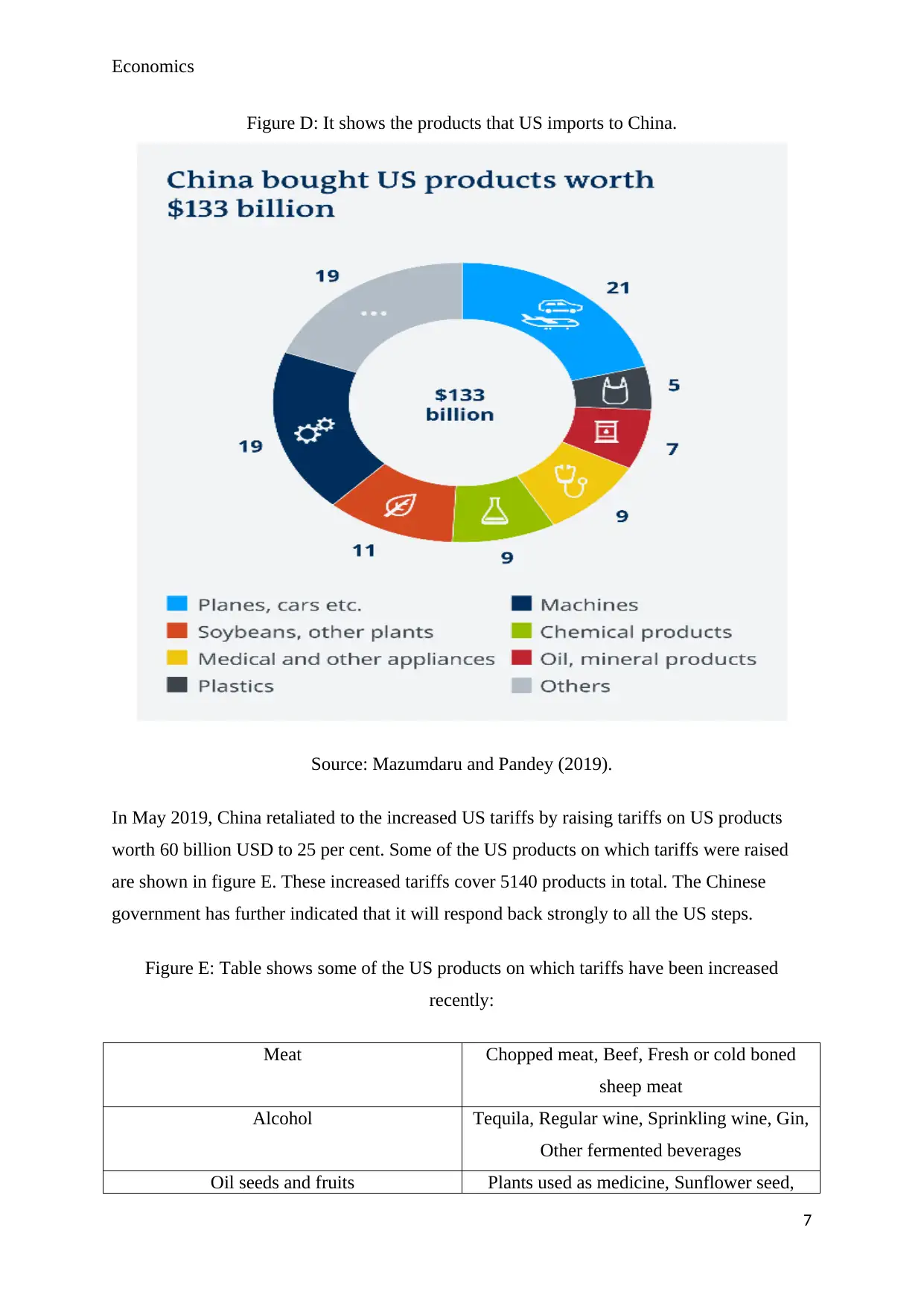
Economics
Figure D: It shows the products that US imports to China.
Source: Mazumdaru and Pandey (2019).
In May 2019, China retaliated to the increased US tariffs by raising tariffs on US products
worth 60 billion USD to 25 per cent. Some of the US products on which tariffs were raised
are shown in figure E. These increased tariffs cover 5140 products in total. The Chinese
government has further indicated that it will respond back strongly to all the US steps.
Figure E: Table shows some of the US products on which tariffs have been increased
recently:
Meat Chopped meat, Beef, Fresh or cold boned
sheep meat
Alcohol Tequila, Regular wine, Sprinkling wine, Gin,
Other fermented beverages
Oil seeds and fruits Plants used as medicine, Sunflower seed,
7
Figure D: It shows the products that US imports to China.
Source: Mazumdaru and Pandey (2019).
In May 2019, China retaliated to the increased US tariffs by raising tariffs on US products
worth 60 billion USD to 25 per cent. Some of the US products on which tariffs were raised
are shown in figure E. These increased tariffs cover 5140 products in total. The Chinese
government has further indicated that it will respond back strongly to all the US steps.
Figure E: Table shows some of the US products on which tariffs have been increased
recently:
Meat Chopped meat, Beef, Fresh or cold boned
sheep meat
Alcohol Tequila, Regular wine, Sprinkling wine, Gin,
Other fermented beverages
Oil seeds and fruits Plants used as medicine, Sunflower seed,
7
⊘ This is a preview!⊘
Do you want full access?
Subscribe today to unlock all pages.

Trusted by 1+ million students worldwide
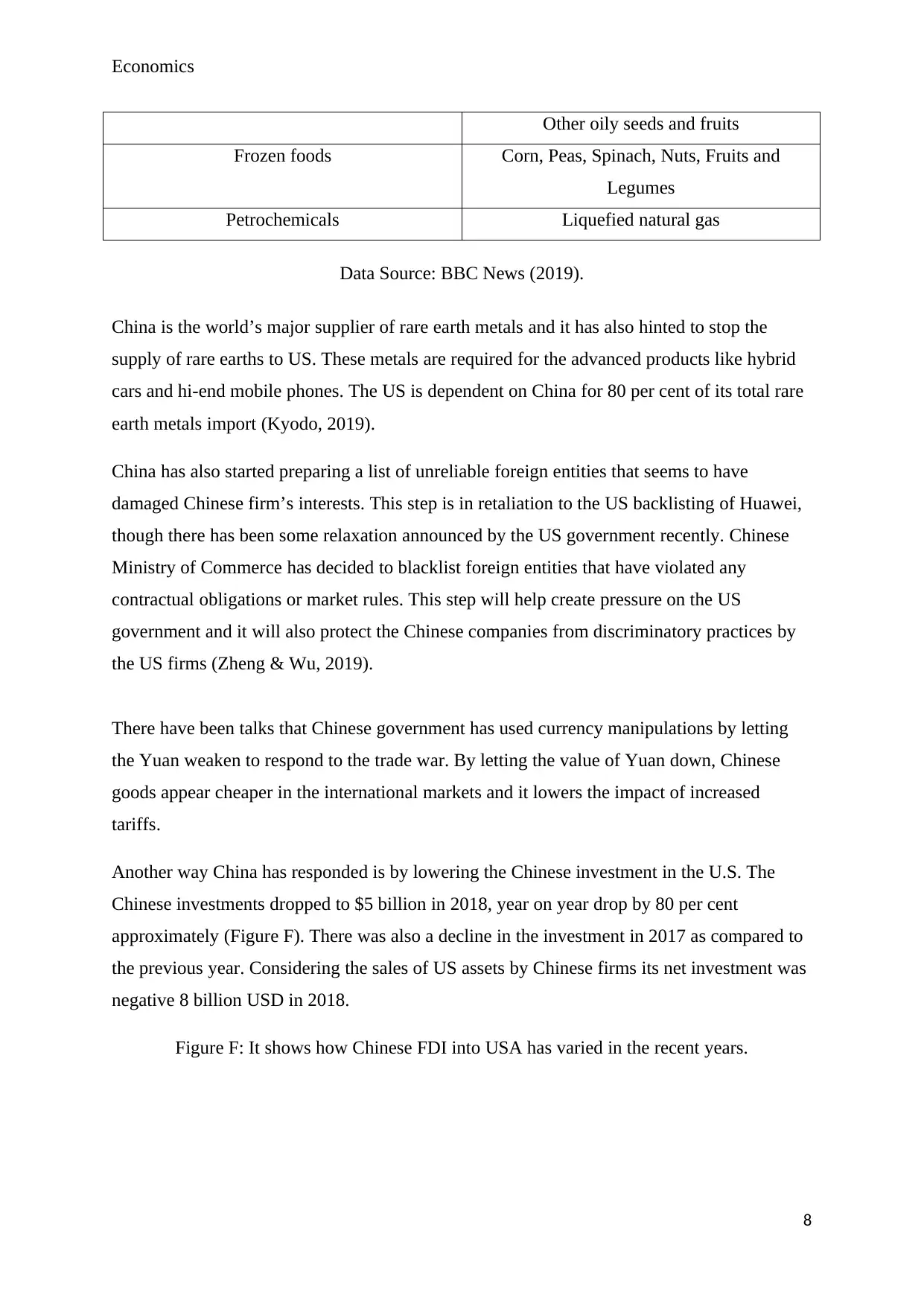
Economics
Other oily seeds and fruits
Frozen foods Corn, Peas, Spinach, Nuts, Fruits and
Legumes
Petrochemicals Liquefied natural gas
Data Source: BBC News (2019).
China is the world’s major supplier of rare earth metals and it has also hinted to stop the
supply of rare earths to US. These metals are required for the advanced products like hybrid
cars and hi-end mobile phones. The US is dependent on China for 80 per cent of its total rare
earth metals import (Kyodo, 2019).
China has also started preparing a list of unreliable foreign entities that seems to have
damaged Chinese firm’s interests. This step is in retaliation to the US backlisting of Huawei,
though there has been some relaxation announced by the US government recently. Chinese
Ministry of Commerce has decided to blacklist foreign entities that have violated any
contractual obligations or market rules. This step will help create pressure on the US
government and it will also protect the Chinese companies from discriminatory practices by
the US firms (Zheng & Wu, 2019).
There have been talks that Chinese government has used currency manipulations by letting
the Yuan weaken to respond to the trade war. By letting the value of Yuan down, Chinese
goods appear cheaper in the international markets and it lowers the impact of increased
tariffs.
Another way China has responded is by lowering the Chinese investment in the U.S. The
Chinese investments dropped to $5 billion in 2018, year on year drop by 80 per cent
approximately (Figure F). There was also a decline in the investment in 2017 as compared to
the previous year. Considering the sales of US assets by Chinese firms its net investment was
negative 8 billion USD in 2018.
Figure F: It shows how Chinese FDI into USA has varied in the recent years.
8
Other oily seeds and fruits
Frozen foods Corn, Peas, Spinach, Nuts, Fruits and
Legumes
Petrochemicals Liquefied natural gas
Data Source: BBC News (2019).
China is the world’s major supplier of rare earth metals and it has also hinted to stop the
supply of rare earths to US. These metals are required for the advanced products like hybrid
cars and hi-end mobile phones. The US is dependent on China for 80 per cent of its total rare
earth metals import (Kyodo, 2019).
China has also started preparing a list of unreliable foreign entities that seems to have
damaged Chinese firm’s interests. This step is in retaliation to the US backlisting of Huawei,
though there has been some relaxation announced by the US government recently. Chinese
Ministry of Commerce has decided to blacklist foreign entities that have violated any
contractual obligations or market rules. This step will help create pressure on the US
government and it will also protect the Chinese companies from discriminatory practices by
the US firms (Zheng & Wu, 2019).
There have been talks that Chinese government has used currency manipulations by letting
the Yuan weaken to respond to the trade war. By letting the value of Yuan down, Chinese
goods appear cheaper in the international markets and it lowers the impact of increased
tariffs.
Another way China has responded is by lowering the Chinese investment in the U.S. The
Chinese investments dropped to $5 billion in 2018, year on year drop by 80 per cent
approximately (Figure F). There was also a decline in the investment in 2017 as compared to
the previous year. Considering the sales of US assets by Chinese firms its net investment was
negative 8 billion USD in 2018.
Figure F: It shows how Chinese FDI into USA has varied in the recent years.
8
Paraphrase This Document
Need a fresh take? Get an instant paraphrase of this document with our AI Paraphraser

Economics
Source: Schott, Chorzempa and Lu (2019).
China provides a huge market for various foreign products. Another way in which China has
responded to the trade war is by lowering its purchase of the USA products. This resulted in
lower US exports of soybeans and other agricultural products. In-spite of this decrease China
is still dominant export market for US agricultural products, so it holds further leverage. In
2017, China bought US farm products worth USD 14 billion and this purchase reduced to
USD 9.3 billion in 2018 because of its retaliation to the trade war (Figure G). This reduced
US farm income to USD 69.4 billion, approximately 45 per cent lower than the 2013 high.
This made US government to promise its farmers a subsidy/aid of USD 12 billion and USD
15 billion in recent years (Layne, 2019).
Figure G: It shows this reduction in the US Soybean exports in recent years.
9
Source: Schott, Chorzempa and Lu (2019).
China provides a huge market for various foreign products. Another way in which China has
responded to the trade war is by lowering its purchase of the USA products. This resulted in
lower US exports of soybeans and other agricultural products. In-spite of this decrease China
is still dominant export market for US agricultural products, so it holds further leverage. In
2017, China bought US farm products worth USD 14 billion and this purchase reduced to
USD 9.3 billion in 2018 because of its retaliation to the trade war (Figure G). This reduced
US farm income to USD 69.4 billion, approximately 45 per cent lower than the 2013 high.
This made US government to promise its farmers a subsidy/aid of USD 12 billion and USD
15 billion in recent years (Layne, 2019).
Figure G: It shows this reduction in the US Soybean exports in recent years.
9
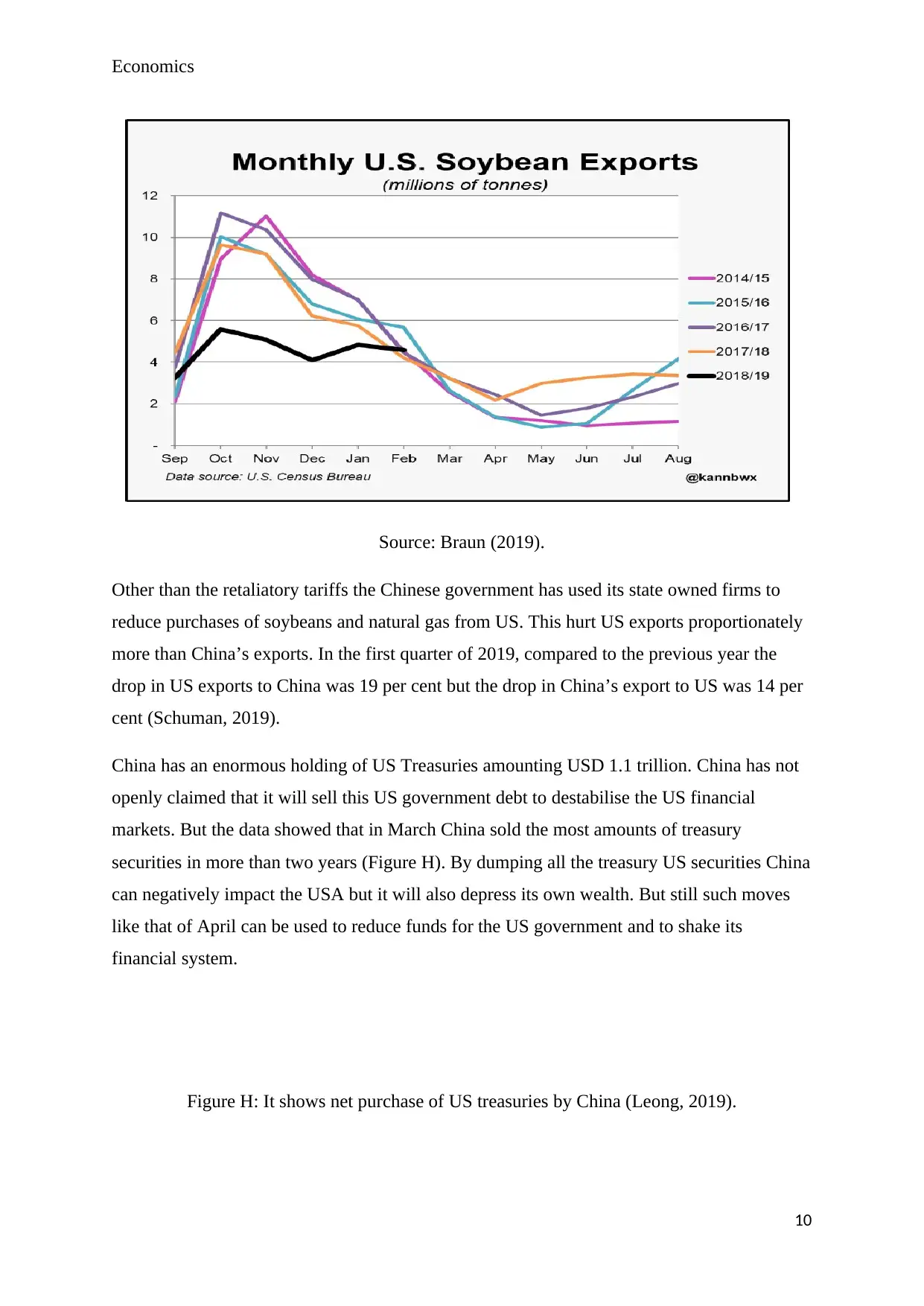
Economics
Source: Braun (2019).
Other than the retaliatory tariffs the Chinese government has used its state owned firms to
reduce purchases of soybeans and natural gas from US. This hurt US exports proportionately
more than China’s exports. In the first quarter of 2019, compared to the previous year the
drop in US exports to China was 19 per cent but the drop in China’s export to US was 14 per
cent (Schuman, 2019).
China has an enormous holding of US Treasuries amounting USD 1.1 trillion. China has not
openly claimed that it will sell this US government debt to destabilise the US financial
markets. But the data showed that in March China sold the most amounts of treasury
securities in more than two years (Figure H). By dumping all the treasury US securities China
can negatively impact the USA but it will also depress its own wealth. But still such moves
like that of April can be used to reduce funds for the US government and to shake its
financial system.
Figure H: It shows net purchase of US treasuries by China (Leong, 2019).
10
Source: Braun (2019).
Other than the retaliatory tariffs the Chinese government has used its state owned firms to
reduce purchases of soybeans and natural gas from US. This hurt US exports proportionately
more than China’s exports. In the first quarter of 2019, compared to the previous year the
drop in US exports to China was 19 per cent but the drop in China’s export to US was 14 per
cent (Schuman, 2019).
China has an enormous holding of US Treasuries amounting USD 1.1 trillion. China has not
openly claimed that it will sell this US government debt to destabilise the US financial
markets. But the data showed that in March China sold the most amounts of treasury
securities in more than two years (Figure H). By dumping all the treasury US securities China
can negatively impact the USA but it will also depress its own wealth. But still such moves
like that of April can be used to reduce funds for the US government and to shake its
financial system.
Figure H: It shows net purchase of US treasuries by China (Leong, 2019).
10
⊘ This is a preview!⊘
Do you want full access?
Subscribe today to unlock all pages.

Trusted by 1+ million students worldwide
1 out of 28
Related Documents
Your All-in-One AI-Powered Toolkit for Academic Success.
+13062052269
info@desklib.com
Available 24*7 on WhatsApp / Email
![[object Object]](/_next/static/media/star-bottom.7253800d.svg)
Unlock your academic potential
Copyright © 2020–2025 A2Z Services. All Rights Reserved. Developed and managed by ZUCOL.





